This guide initially displays all common fish regardless of shape. Use the selectors below to include rare fish or select a specific set, either by shape or name.
Nearby waterways are home to a variety of native and introduced fish. The geographical range for this guide is a bit broader than some of our other guides, encompassing not just Los Alamos and the Pajarito Plateau (which has very few fish!) but also nearby stretches of the Rio Grande, the Jemez River drainage, and nearby lakes, such as Cochiti and Fenton.
Fish Guide References
Biota Information System
FishBase Consortium
New Mexico Game and Fish
Sublette, J., Hatch, M.D, and Sublette, M., 1990 The Fishes of New Mexico. University of New Mexico Press
US Geological Survey Nonindigenous Aquatic Species
Subject Area Experts (all guides)
Steve Cary (butterflies)
Beth Cortright (insects)
Terry Foxx (invasive plants)
Leslie Hansen (mammals)
Richard Hansen (fish, mammals)
Dorothy Hoard (butterflies, trees)
Chick Keller (flowers, herbarium)
Shari Kelley (geology)
Kirt Kempter (geology)
Garth Tietjen (reptiles)
David Yeamans (birds)
Web Development and Content Management
Pat Bacha
Jennifer Macke
Graham Mark
Akkana Peck
Contact
Please contact us for local nature questions and sightings. We welcome comments, corrections, and additions to our guides.
For more information about local nature, please visit our Nature Blog or subscribe to PEEC This Week.
Make Selection
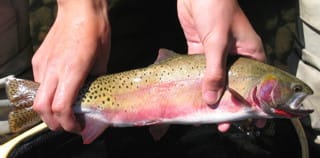 Photo: US Fish and Wildlife Service |  Rio Grande Cutthroat Trout(Oncorhynchus clarkii virginalis)Family: Salmonidae (Trout and Salmon) Size: up to 10 in (25 cm) Status: native; uncommon; sensitive species Habitat: cold water bodies of freshwater Typical location: Rio Cebolla near the Hatchery, Rio Grande The only native trout in this area. In some places it interbred with rainbow trout, resulting in "cutbow trout". Feeds on aquatic insects and terrestrial insects that fall into the water. Info Photos Distribution |
 Photo: Mark Lisac/US Fish and Wildlife Service |  Rainbow Trout(Oncorhynchus mykiss)Family: Salmonidae (Trout and Salmon) Size: up to 45 in (114 cm) Status: introduced; common Habitat: bodies of freshwater Typical location: Fenton Lake, Rio Grande Popular sport fish. The rainbow trout that are stocked for sport fishing in New Mexico are triploids, which are unable to reproduce in the wild. It is a predator, eating insects, fish eggs and juvenile fish. Info Photos Distribution |
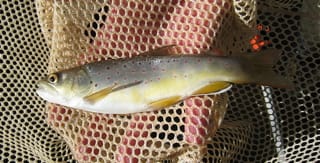 Photo: Jennifer Macke |  Brown Trout, Sea Trout(Salmo trutta)Family: Salmonidae (Trout and Salmon) Size: up to 40 in (102 cm) Status: introduced; common Habitat: freshwater streams and lakes Typical location: Jemez River Drainage Introduced from Europe in the 1880s as a food fish. It is the most common trout in the Jemez River. Feeds on insects and other fish. Info Photos Distribution |
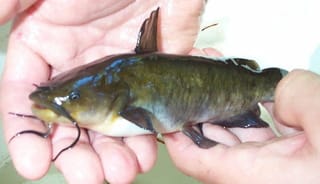 Photo: David Berman |  Black Catfish, Black Bullhead(Ameiurus melas)Family: Ictaluridae (North American Catfish) Size: up to 24 in (61 cm) Status: introduced; common Habitat: low gradient sections of water, areas over silty soft mud Typical location: Cochiti Lake, Rio Grande Game fish that feeds on a variety of plant and animal materials from the bottom. Native to Europe and Asia. Info Photos Distribution |
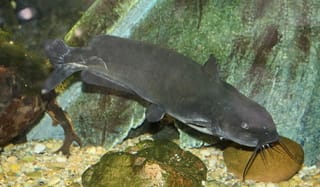 Photo: Cliff |  Channel Catfish(Ictalurus punctatus)Family: Ictaluridae (North American Catfish) Size: up to 36 in (91 cm) Status: introduced; common Habitat: wide variety of freshwater habitats Typical location: Cochiti Lake, Rio Grande Feeds primarily on aquatic invertebrates. Native to the Canadian drainage and widely introduced elsewhere in New Mexico. Info Photos Distribution |
Photo: Tyson Research Center |  Green Sunfish(Lepomis cyanellus)Family: Centrarchidae (Sunfishes) Size: up to 12 in (30 cm) Status: introduced; common Habitat: sluggish backwaters, ponds with gravel, sand, or rocky bottoms Typical location: Cochiti Lake, Rio Grande Has a varied diet including insects, larvae, and small invertebrates. Info Photos Distribution |
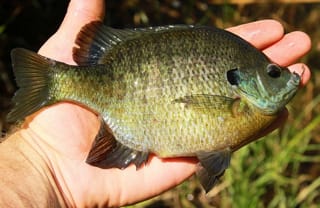 Photo: Jon Nelson |  Bluegill Sunfish, Bluegill(Lepomis macrochirus)Family: Centrarchidae (Sunfishes) Size: up to 11.5 in (29 cm) Status: native; locally common Habitat: quiet lake or river waters Typical location: Cochiti Lake, Rio Grande Feeds on aquatic insects, crayfish, and small fish. Likes slower water. Info Photos Distribution |
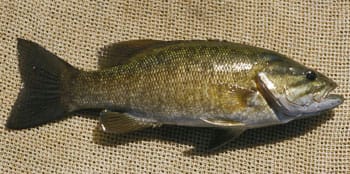 Photo: John Lyons |  Smallmouth Bass, Brown Bass(Micropterus dolomieu)Family: Centrarchidae (Sunfishes) Size: up to 20 in (51 cm) Status: introduced; common Habitat: mid-sized streams and bodies of water with cool, clear water and rocky substrate Typical location: Cochiti Lake More common in local rivers than the Largemouth Bass. Feeds on insects, crayfish, and various fish. Native to north-central USA. Info Photos Distribution |
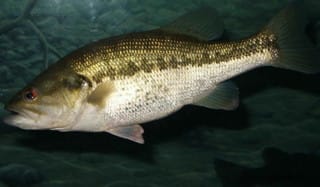 Photo: Robert H Pos/US Fish and Wildlife Service |  Largemouth Bass(Micropterus salmoides)Family: Centrarchidae (Sunfishes) Size: up to 38 in (97 cm) Status: introduced; locally common Habitat: quiet, clear to slightly turbid bodies of water with vegetation or other cover Typical location: Cochiti Lake One of the most highly prized sport fishes in the US. Feeds primarily on other fish. Native to the Pecos drainage but not to the Rio Grande. Info Photos Distribution |
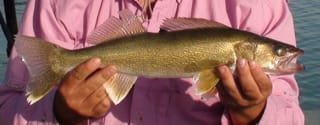 Photo: Philip Marley |  Walleye(Sander vitreus)Family: Percidae (Perches) Size: up to 32 in (81 cm) Status: introduced; common Habitat: large bodies of water, tolerant of a wide variety of habitats Typical location: Cochiti Lake Native to eastern and central USA, but widely cultured and has been introduced in many areas. Info Photos Distribution |
 Photo: David Cole |  River Carpsucker(Carpiodes carpio)Family: Catostomidae (Suckers) Size: up to 25 in (64 cm) Status: introduced; common Habitat: slow-moving water; lakes, pools and backwaters of creeks and rivers Typical location: Cochiti Lake Game fish which feeds on organic detritus. Info Photos Distribution |
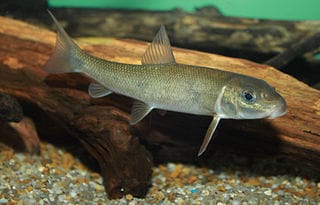 Photo: Brian Gratwicke |  White Sucker(Catostomus commersoni)Family: Catostomidae (Suckers) Size: up to 20 in (51 cm) Status: introduced; common Habitat: small streams and other bodies of water Typical location: Lower Jemez River Drainage, Rio Grande A bottom feeder that will eat almost anything. Highly adaptable to changing environmental conditions. Info Photos Distribution |
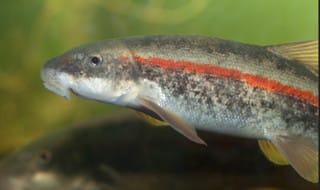 Photo: Rio Grande Sucker photographed in captivity at PEEC by Jennifer Macke 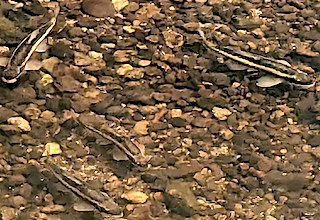 Photo: Rio Grande Suckers photographed in the East Fork of the Jemez River by Akkana Peck |  Rio Grande Sucker(Catostomus plebeius, Pantosteus plebieus)Family: Catostomidae (Suckers) Size: up to 12 in (30 cm) Status: native; locally common Habitat: Areas near rapidly flowing water Typical location: Jemez River Drainage Feeds on diatoms, detritus and aquatic invertebrates. Seen near banks adjacent to fast waters during the day. Historically present in the Rio Grande but was driven out by the White Sucker. Info Photos Distribution |
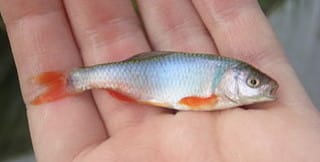 Photo: Marine Discovery |  Red Shiner(Cyprinella lutrensis)Family: Cyprinidae (Minnows and Carps) Size: up to 3.5 in (9 cm) Status: native; common Habitat: variety of habitats, including ephemeral habitats and water with high turbidity, slow flowing riffles, and pools Typical location: Cochiti Lake, Rio Grande below Cochiti Lake Tolerates poor water conditions and is often used as a bait fish. Info Photos Distribution |
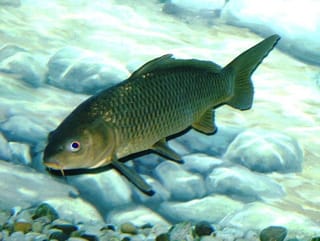 Photo: Robert H. Pos/US Fish and Wildlife Service |  Common Carp(Cyprinus carpio)Family: Cyprinidae (Minnows and Carps) Size: up to 30 in (76 cm) Status: introduced; locally common Habitat: bodies of water with clear to turbid water Typical location: Cochiti Lake, Rio Grande Introduced to the US from Europe in the 1880s as a food fish but has not become popular. Info Photos Distribution |
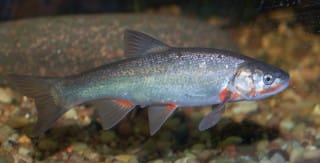 Photo: Jennifer Macke |  Rio Grande Chub(Gila pandora, Clinostomus pandora)Family: Cyprinidae (Minnows and Carps) Size: up to 12.5 in (32 cm) Status: native; common Habitat: flowing pools of headwaters, creeks and small rivers, usually near brush Typical location: Fenton Lake, Rio Grande Feeds on plankton, insects, juvenile fish, and occasional detritus. Info Photos Distribution |
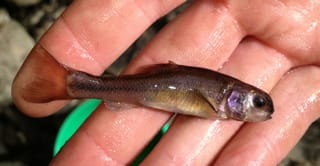 Photo: Zack Abbey |  Fathead Minnow, Rosy-red Minnow(Pimephales promelas)Family: Cyprinidae (Minnows and Carps) Size: up to 4 in (10 cm) Status: native; common Habitat: small bodies of water and wetlands, in which they are tolerant of harsh conditions Typical location: Rio Grande Used as a baitfish and sold in pet shops as the rosy-red minnow. Often used as a marker in aquatic toxicology studies. Found mostly in lakes and ponds but sometimes in streams. Info Photos Distribution |
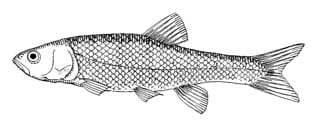 Photo: Pearson Scott Foresman |  Flathead Chub, Saskatchewan Dace(Platygobio gracilis, Cyprinus gracilis)Family: Cyprinidae (Minnows and Carps) Size: up to 12 in (30 cm) Status: native; common Habitat: sandy runs of small to large turbid waters Typical location: Lower Jemez River Drainage between San Ysidro and Rio Grande, Rio Grande Feeds mainly on terrestrial and aquatic insects and occasionally on small fishes. Info Photos Distribution |
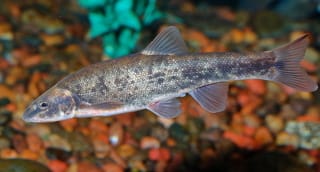 Photo: Bob Walker |  Longnose Dace(Rhinichthys cataractae)Family: Cyprinidae (Minnows and Carps) Size: up to 7 in (18 cm) Status: native; common Habitat: turbid streams over gravel or rocks Typical location: Rio Grande in White Rock Canyon, Upper Jemez River Drainage Feeds on aquatic insects. Often found in fast-moving water with riffles. Info Photos Distribution |
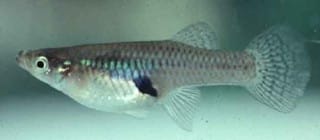 Photo: US Fish and Wildlife Service |  Western Mosquitofish(Gambusia affinis)Family: Poeciliidae (Rivulines and Killifishes) Size: up to 2.5 in (6 cm) Status: introduced; common Habitat: standing or slow-flowing water, mostly in shallow vegetated ponds and quiet pools of streams, cattle tanks Typical location: Lower Jemez River Drainage, Rio Grande in side ponds Feeds on plankton, small insects and detritus. Effective in mosquito control. Found in ephemeral water and at lower elevations. Info Photos Distribution |
